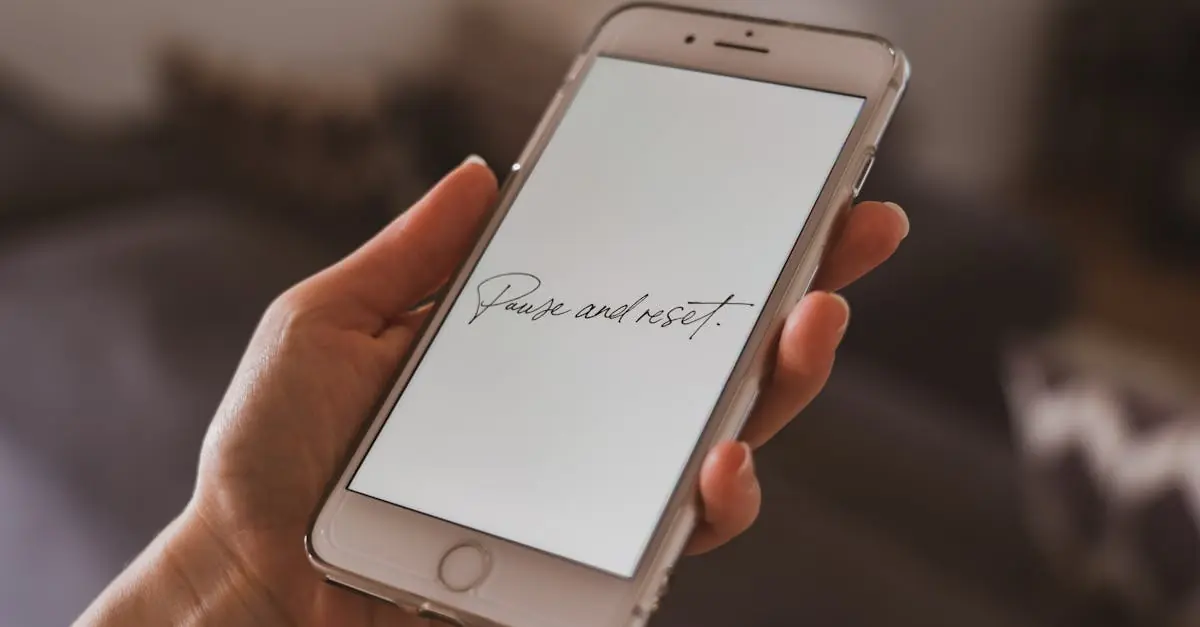Ever found yourself in a technological pickle with your iPhone? Maybe your apps are acting like rebellious teenagers or your settings seem to have a mind of their own. Fear not! The “Reset All Settings” option is like the magic wand you didn’t know you needed. It promises to bring harmony back to your device without the hassle of a full factory reset.
Table of Contents
ToggleUnderstanding Reset All Settings
Reset All Settings on an iPhone allows users to return their device settings to the defaults without erasing personal data. This function’s primary purpose is to resolve configuration issues that cause apps or features to misbehave.
After confirmation, this process restores settings for network connections, display preferences, and privacy options. The reset does not delete user content like photos, apps, or messages. Users often choose this option to fix issues such as poor battery performance or connectivity problems, helping to quickly restore optimal functionality.
Settings for Wi-Fi networks and Bluetooth connections revert to their original states. Users may need to reconnect to Wi-Fi networks and pair Bluetooth devices again after the reset. Additionally, preferences for notifications, wallpaper, and accessibility options return to their defaults.
General settings, such as location services and Do Not Disturb preferences, also reset. Some users might find adjusting settings tedious after the reset. However, this method provides a straightforward approach to troubleshooting specific issues without extensive data loss.
This approach can benefit those experiencing persistent problems. They can regain control over their device’s settings with minimal hassle. Users looking for a quick fix often find Reset All Settings an efficient solution to restore normalcy to their iPhone’s performance.
Impact on iPhone Functionality
Resetting all settings on an iPhone significantly impacts its overall functionality. Users notice immediate changes in their device’s behavior, often resolving ongoing issues.
Effects on System Preferences
System preference settings undergo a complete reset. This includes adjustments like Display Brightness, Night Shift schedules, and sound settings. Users return to the default configurations, which might differ from their personalized setups. Notification preferences revert as well, affecting how and when alerts appear. Consequently, users may need to re-customize layouts or accessibility features to match their previous experiences.
Effects on Network Settings
Network settings also reset, affecting connections to Wi-Fi and Bluetooth. Users find saved Wi-Fi passwords and Bluetooth pairings removed, necessitating re-entering credentials or re-establishing connections. This impacts both internet access and peripheral device usability. VPN configurations restore to defaults, which could disrupt secured connections previously established. Upon completion of the reset, users regain the ability to troubleshoot connectivity issues and improve overall network performance.
When to Use Reset All Settings
“Reset All Settings” provides an effective way to address various issues without risking personal data loss. Users often find it beneficial in specific scenarios.
Common Scenarios
Malfunctioning apps frequently prompt users to consider resetting all settings. Persistent connectivity issues can also lead users to this option. Users experiencing battery drain may find that resetting settings restores optimal performance. Specific user complaints about display preferences reverting unexpectedly indicate a potential need for this reset. Some users turn to this option when facing problems with notifications not appearing correctly, especially if they rely on timely updates. Users should find that this reset offers swift recovery of preferred iPhone functionality without losing personal data.
Precautions to Consider
Before proceeding, users should consider backing up their data, ensuring every important file is saved. Reconnecting to Wi-Fi networks after the reset can present challenges, as saved passwords will disappear. Bluetooth pairings also require re-establishing connections, which might cause inconvenience in daily use. Adjustments to privacy and location settings may be necessary, as defaults may differ from user preferences. Users relying on VPN configurations should document necessary settings beforehand, because they may reset to original states. Awareness of these precautions can help users navigate post-reset adjustments seamlessly.
How to Perform a Reset All Settings
Resetting all settings on an iPhone is straightforward. Follow these steps to execute the process effectively.
Step-by-Step Guide
- Open the Settings app on the iPhone.
- Tap on General.
- Scroll down and select Transfer or Reset iPhone.
- Choose Reset.
- Tap Reset All Settings.
- Enter the device passcode when prompted.
- Confirm the action by tapping Reset All Settings again.
Executing these steps restores all settings to their defaults, preserving personal data like photos and apps.
Tips for a Successful Reset
Back up important data, as specific settings might reset. Ensure the device is charged or plugged in to avoid interruptions. Document any Wi-Fi passwords and Bluetooth pairings because you’ll need to reconnect after the reset. Familiarize yourself with settings that revert to default, including Do Not Disturb and location preferences. After completing the reset, revisit customized settings to restore the desired functionality.
Resetting all settings on an iPhone can be a game changer for users facing persistent issues. This option provides a quick fix to restore default configurations without losing personal data. By addressing common problems like connectivity issues or app malfunctions, it helps users regain optimal device performance.
While some adjustments will be needed post-reset, the benefits often outweigh the temporary inconvenience. Users can effectively troubleshoot their devices and enhance overall functionality. With the right approach and careful preparation, utilizing the “Reset All Settings” feature can lead to a smoother and more efficient iPhone experience.



